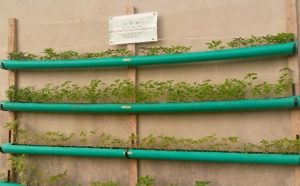Vertical Gardens Combat Climate Change Within African Cities
Vertical gardens combat plastic pollution and urban heat, offering sustainable solutions for low-income areas. Olumuyiwa Adegun showcases two prototypes that have the potential to transform urban landscapes and prove sustainable housing does not need to be expensive or high-tech.
While extreme temperatures of 41-55°C have been reported in Nigeria’s commercial capital, Lagos, climate projections for the sub-Sahara Africa region indicate a future with warming trends, increasing aridity and frequent extreme heat events.
But the heat isn’t the only challenge African cities like Lagos face. Urbanisation and poverty in African cities add to the challenge of extreme heat associated with climate change. As cities swell with newborns and newcomers, affordable shelter is usually out of reach for the most urban residents. Consider Lagos, for instance, a megacity that contains around 20 million people with an estimated 60 per cent of the population living in low-income areas categorised as slums or informal settlements.
Amidst those challenges, green infrastructure offers a lifeline to sustainable cities, especially within slums and low-income communities, often receiving little attention from policymakers.
Low-Cost Vertical Gardens Combat Plastic Pollution
Did you know that around 75,000 metric tons of plastic bottles are used in Lagos in a year (Ibukun, 2019)? Shockingly, a significant portion of these bottles ends up as litter, particularly in underserved neighbourhoods like slums, exacerbating environmental degradation and health hazards for residents.
In our research project, we developed and implemented two prototypes of low-cost vertical greening systems using recycled PET bottles and HDPE pipes. The first prototype ingeniously repurposes PET bottles, a readily available and inexpensive material, to create vertical green walls. By transforming waste into functional green infrastructure, we not only mitigate plastic pollution but also promote affordability and sustainability.
The second prototype is made from HDPE pipes placed horizontally and hung on vertical timber planks. The prototype has advantages in terms of cost, ease of construction and better visual quality. In 2019, a standard HDPE prototype typically costs approximately 30,460 naira (US$79) to procure and install.
Our prototypes were implemented on residential buildings in Akure and Lagos (figure 1). To maximise impact, we planted three indigenous leafy vegetables (jute leaf; Lagos spinach; and African spinach) — fostering not only environmental sustainability but also food security.
Vertical Gardens Beat the Heat in Homes
After setting up the prototypes, we undertook a comprehensive field study in Akure, measuring indoor temperatures was undertaken for 45 days using the i-button Thermochron data logger. The data logging sought to compare the indoor ambient temperature within two bedrooms of the same size, same location, similar interior finishing and within the same wing of the building. However, there was one crucial difference – one of the rooms had vertical gardens on its wall, while the other did not.

Vertical gardens on the wall of residential buildings in Akure and Lagos, Nigeria. © Olumuyiwa Bayode Adegun
Throughout the 45-day monitoring period in 2021, which was towards the end of the annual rainy season when conditions were hot and humid, the room adorned with our vertical garden consistently maintained lower indoor temperature compared to its barren counterpart. The disparity was striking, with a maximum difference of 2.880C maximum temperature and 0.70C minimum temperature recorded.
The highest temperature difference of 4.230C at 17:00h and 2.00C at 23:00h were recorded on the hottest and coldest days respectively. Beyond their cooling effects, the vertical green structures had a notable contribution of vegetables to the households where they were developed.
Greening Challenges: Overcoming Hurdles to Vertical Garden Optimisation
This vertical gardens’ design and implementation showed not only tangible results but offered useful lessons. For vertical greening to scale up, some challenges must be overcome. These include:
- Optimising plant yield: The two prototypes implemented contributed vegetables, but the yield was not optimal. This is attributed to high solar insolation and the small size of the growth media. Addressing these factors could significantly improve plant productivity.
- Automating Irrigation: Vertical greening systems require regular watering, which is currently done manually at scheduled intervals for both prototypes. Regular watering takes time and is challenging in the absence of potable water supply within slums. Developing automated irrigation systems could streamline this process.
- Maximising Vertical Surfaces: Vertical greening usually requires solid blank walls on which the structure containing soil and plants can adequately rest. Increasing fenestration sizes within the tropics reduces wall surfaces available for gardening. Another worry is that external walls can get wet with continual watering of the vertical gardens.
- Mitigating Pests and Animals: Like other vegetation, vertical gardens are subject to attack from pests and domestic animals who feed on sprouting vegetables. They also attract birds, lizards, snakes, etc. These animals’ interaction with the green walls poses a risk to the residents.
- Addressing Socio-cultural dimensions: Human perceptions, mostly related to phobias, affect prospects of vertical greening. For example, the fear of harvesting crops located at higher levels may hinder adoption.
- Navigating tenure status: Installing vertical gardens might require alteration to existing walls. Tenants therefore need approval from landlords or homeowners before execution, which can be a barrier to implementation.
By addressing these challenges, vertical greening can become a more scalable and sustainable solution, offering both tangible benefits and valuable lessons for the future.
Sustainable Solutions: Vertical Gardening in Urban Informal Settlements
The potential of vertical greening in slums is undeniable, offering a promising solution to congestion and the lack of green spaces often found in these areas. Moreover, it addresses the challenges of urban agriculture where limited land and polluted soil pose barriers. Our implemented prototypes show that solutions do not have to be expensive or high-tech.

Vertical gardens on the wall of residential buildings in Akure and Lagos, Nigeria. © Olumuyiwa Bayode Adegun
The yield from vertical gardening can be scaled, providing a sustainable source of fresh produce. Additionally, its contribution to micro-climate control is notable and part of passive energy-efficiency strategies, which are especially crucial for people living in slums that generally lack services; hence, options of mechanical devices for active cooling are limited. Improved thermal performance through vertical greening addresses heat stress and cuts energy costs in low-income settings.
While municipalities are trying to build parks and other green open spaces – usually in affluent neighbourhoods – it is crucial to evolve initiatives that promote citizen-led and community-based low-cost vertical farming in the densifying low-income informal settlements. Incentivising such projects tailored to each local community can help the innovation gain traction. By encouraging vertical greening, we can address heat stress and reduce energy costs in low-income housing. It’s time to prioritise affordable microclimate control solutions and empower communities to create greener, healthier environments for all residents.
- Vertical Gardens Combat Climate Change Within African Cities - 9. April 2024
